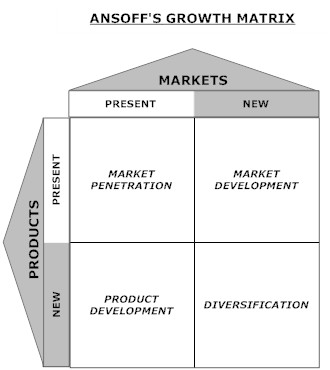Want to grow your business but unsure how to go about it?
In the late fifties a gentleman called Igor Ansoff created his now well known matrix, which highlighted four specific ways in which a business could develop strategies for growth. Now that sounds nice and simple when put that way, but is it really as simple as that?
Ansoff’s matrix was first seen in the late fifties in the Harvard Business review and is regularly used today by marketers to provide a structured way of developing a range of strategic choices by which to grow a business. The matrix, offers four potential strategic directions for growth. The matrix takes into account the ability to grow a business by leveraging new or existing products via new or existing markets. Ansoff named these four strategic directions as follows;
- Market Penetration
- Product Development
- Market Development
- Diversification
Present Market/Present Products= Market Penetration
This is the most simple of the four strategies. In this situation there would be no change to product or the markets the organisations is targeting. Ansoff suggests that to grow under these circumstances would require a market penetration strategy.
This would mean increasing market share at the expense of your competitors. In a static market you would gain share at the expense of your competitors. This could result in a price war. Do you have the capability and commitment to defend such a situation? Typical ways of increasing market share would involve a mix of increased advertising, price discounting and using push (direct ) selling strategies into existing and clearly defined markets.
New Market/Present Products = Market Development
Here we are involved in marketing existing products to new markets. Typical new markets could be simply geographic expansion; exporting for instance. It could be a new use for an old product. For example water-soluble polymers (product) originally designed for rapid control of urine capture in babies nappies were marketed as an additive for potted plants that needed a constant source of water. This is an example of an existing product in a new market.
Present Market/New Products = Product Development
This is where we would market new products to existing markets. The motor industry is a classical example where product development is used to gain a competitive advantage in an existing market. Motor companies develop new products on regular basis to keep ahead of the market. Product development involves an amount of risk due to the time and effort spent on developing a new product and marketing before you create revenue. However the rewards are there if you get it right! It is also less risky in following a strategy of product development as opposed to market diversification.
Two great examples of product development include quartz watches and digital cameras. These products changed their markets dramatically. Kodak have since the evolution of digital cameras decided to stop making traditional film cameras.
New Markets/New Products = Market Diversification
This would be where we would market new products to new markets. This is termed Market Diversification.
There are two types of diversification; related and unrelated. For example the brewing industry and manufactures of crisps are different markets but can be considered related (food Industry). On the other hand should the brewing company decide to manufacture cars then this would be considered unrelated diversification.
Market Diversification is the highest risk area in developing marketing strategies for growth. Getting it wrong here can be expensive. However many companies have been successful in pursuing a market diversification strategy. As an example supermarket chains in the UK and overseas have diversified into non food related products such as insurance and banking with a degree of success.
To be successful in this strategic growth arena you must show a real commitment to the program or you will have an increased chance of failure. The supermarket chains who went on a market diversification strategy also had the advantage of a large and mainly loyal existing customer base who went on to buy products that were outside of the supermarkets normal scope of supply. Being able to easily access customers when following a market diversification strategy can significantly minimise the downside risk of failure.
How do you grow your business?
Well how you go about it is entirely up to you. You can choose to develop plans in all four strategic arenas or mix and match depending on your overall capability to manage a varied strategic growth plan. Think about how you are planning to grow your business through products and markets. Complete the Ansoff matrix and see if you have sufficient plans in place that will ensure your business continues to grow and proposer.
If you need any help in developing growth in your business then contact us and we will be pleased to help you think and develop growth!
Filed under: Business, Marketing, Sales, Strategy | Tagged: ansoff growth matrix, grow your business, increasing market share, market development, market diversification, market penetration, product development, strategies for growth | Leave a comment »



